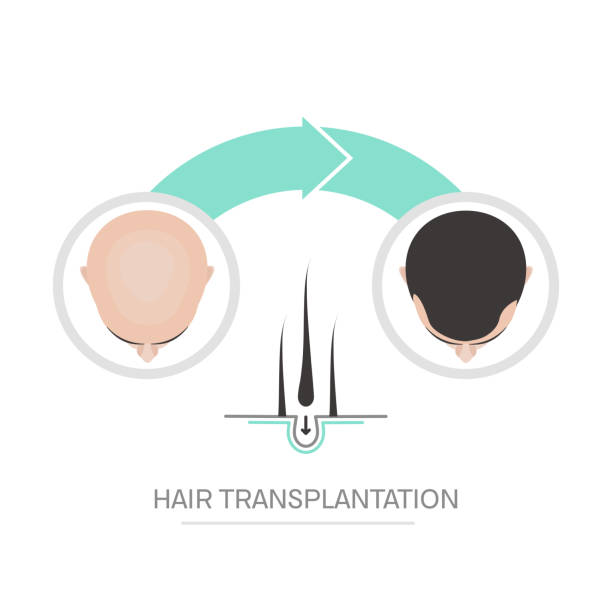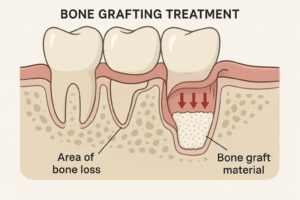What are the bone grafts and why we need before implant?
A bone graft consists of human, bovine or synthetic bone tissue placed on the bone needing augmentation. The dentist uses the demineralized freeze-dried bone for grafting procedures. It is the most widely used grafting material in periodontics.
The bone graft builds up the existing jaw bone and stimulates the growth of new bone, making it possible for the patient to receive a dental implant.
Bone grafting can repair implant sites with inadequate bone structure due to previous extractions, gum disease or injuries. During treatment, The dentist might take tissue bank or your bone from the jaw, hip or tibia (below the knee).
The surgeon also performs bone grafts to replace bone in the posterior upper jaw. In addition, special membranes may be utilized that dissolve under the gum, protect the bone graft, and encourage bone regeneration. The procedure is called guided bone regeneration or guided tissue regeneration.
What is Bone Grafting?
A bone graft is a surgical procedure where natural or synthetic bone material is placed in areas of the jaw with insufficient bone. This graft helps the body generate new bone cells, making the jaw stronger and ready to support dental implants.
The most common bone grafting material used is demineralized freeze-dried bone, which is safe and widely accepted in periodontics and implant dentistry.
Why Do We Need Bone Grafts Before Implants?
A dental implant works like an artificial tooth root. For it to function properly, the implant must be anchored into healthy bone. Without sufficient bone, the implant may loosen, fail, or not integrate with the jaw.
Here are the main reasons why bone grafts are necessary:
-
Tooth Extractions: After a tooth is removed, bone naturally starts to shrink in that area.
-
Gum Disease: Periodontitis destroys both gum and bone around teeth.
-
Injury or Trauma: Accidents can damage or fracture jawbone.
-
Bone Resorption: Over time, missing teeth cause natural bone loss.
-
Sinus Expansion: In upper jaws, the sinus cavity may enlarge, reducing bone height for implants.
With bone grafting, we can rebuild the bone, restore strength, and create the right foundation for implants.
Types of Bone Grafts
Different bone grafting techniques and materials are available. At Esthetica, we select the best option based on the patient’s condition.
1. Autograft (Patient’s Own Bone)
-
Bone is taken from another area of the patient’s body, such as the jaw, hip, or tibia.
-
Considered the gold standard because it has natural bone-forming cells.
2. Allograft (Donor Bone)
-
Bone taken from a tissue bank (human source).
-
Processed and sterilized for safety.
-
Widely used and very effective.
3. Xenograft (Animal Bone)
-
Derived from bovine (cow) or other sources.
-
Biocompatible and promotes natural bone growth.
4. Alloplast (Synthetic Bone)
-
Made from biocompatible materials such as calcium phosphate.
-
Safe, stable, and commonly used in modern dentistry.
How is Bone Grafting Done?
At Esthetica Dental and Maxillofacial Surgery Hospital, we use advanced surgical methods to make bone grafting precise and comfortable.
Step-by-Step Procedure:
-
Examination and Diagnosis
-
3D CBCT scans are taken to measure bone levels.
-
Our dentist designs a personalized grafting plan.
-
-
Anaesthesia
-
Local anaesthesia or sedation ensures a painless experience.
-
-
Bone Preparation
-
A small incision is made to expose the jawbone.
-
-
Placement of Graft
-
Bone material (autograft, allograft, or synthetic) is placed in the deficient area.
-
Membranes may be used to protect the graft.
-
-
Healing Phase
-
The graft fuses with natural bone over several months.
-
-
Dental Implant Placement
-
Once healing is complete, implants are placed securely into the regenerated bone.
-
Recovery After Bone Grafting
Healing is an important part of bone grafting. Here’s what patients can expect:
-
Mild swelling and discomfort for the first few days.
-
Pain is manageable with prescribed medications.
-
Soft foods are recommended for 1–2 weeks.
-
Avoid smoking, as it delays healing.
-
Follow-up appointments ensure proper progress.
Full bone regeneration usually takes 3 to 9 months, depending on the extent of grafting and the type of material used.
Benefits of Bone Grafting Before Implants
Bone grafting is not just about creating bone for implants. It has multiple advantages:
-
Makes dental implants possible for patients with severe bone loss.
-
Restores facial structure and aesthetics.
-
Prevents further bone resorption.
-
Strengthens the jaw for long-term oral health.
-
Provides a natural and permanent solution for missing teeth.
Risks and Complications
Bone grafting is a safe and common procedure. However, like any surgery, it carries small risks:
-
Infection at the graft site.
-
Graft rejection or failure (rare).
-
Swelling, bleeding, or discomfort.
-
Sinus complications in upper jaw grafts.
At Esthetica, we minimize risks through advanced sterilization, careful planning, and skilled execution.
Cost of Bone Grafting in Vadodara, India
The cost of bone grafting depends on the size of the graft, the material used, and whether it is combined with other treatments like sinus lifts or implants.
On average, in Vadodara:
-
Small grafts: ₹15,000 – ₹30,000
-
Moderate grafts: ₹30,000 – ₹60,000
-
Extensive grafting: ₹70,000 – ₹100,000+
At Esthetica Dental and Maxillofacial Surgery Hospital, we offer affordable bone grafting packages with flexible treatment options.
Frequently Asked Questions (FAQs)
No, it is done under local anaesthesia or sedation. Mild discomfort afterward can be managed easily.
Not always. Some patients have enough bone naturally. A CBCT scan helps decide.
Rarely, but smoking or poor oral hygiene can increase risks.
Why Choose Esthetica for Bone Grafting in Vadodara?
At Esthetica Dental and Maxillofacial Surgery Hospital, our goal is to make sure your dental implants last a lifetime.
Here’s why patients trust us:
-
Experienced implant surgeons with advanced training.
-
3D imaging technology for precise planning.
-
Use of world-class grafting materials.
-
Safe, sterile, and minimally invasive procedures.
-
Affordable pricing with transparent treatment plans.
-
Patient-centered care with focus on comfort and results.
Conclusion
Bone grafting is a crucial step for many patients who want strong, reliable, and long-lasting dental implants. It rebuilds lost bone, restores jaw strength, and ensures that implants can be placed successfully.
At Esthetica Dental and Maxillofacial Surgery Hospital, Vadodara, we specialize in bone grafting, sinus lifts, basal implants, and full mouth implant solutions. Our team is here to guide you through every stage of the process with care and expertise.
If you have been told you don’t have enough bone for implants, don’t worry—bone grafting can help.
📞 Call us today at (91) 94084 01616 to schedule your consultation and take the first step toward a confident, natural smile.




